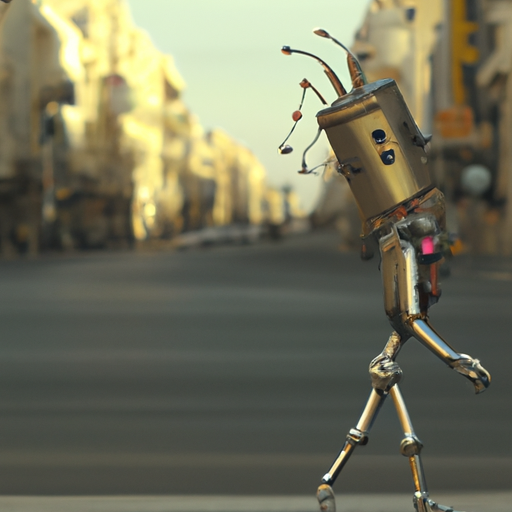A story: One robots experience working for humans

robot wearing jewellery walking in the street
How Robots Can Help Humans in the Workplace
Robots have been used in the workplace for decades, and their presence is becoming increasingly common. As technology advances, robots are becoming more sophisticated and are able to perform a variety of tasks that were once done by humans. Robots can help humans in the workplace in a number of ways.
First, robots can help to increase productivity. By taking on mundane and repetitive tasks, robots can free up human workers to focus on more complex tasks. This can help to increase efficiency and reduce costs. Additionally, robots can work around the clock, meaning that they can complete tasks faster than humans.
Second, robots can help to reduce workplace injuries. By taking on dangerous tasks, robots can help to reduce the risk of injury to human workers. This can help to improve safety in the workplace and reduce the cost of workers’ compensation claims.
Third, robots can help to reduce human error. By taking on tasks that require precision and accuracy, robots can help to reduce the risk of mistakes. This can help to improve the quality of products and services and reduce the cost of rework.
Finally, robots can help to reduce labor costs. By taking on tasks that would otherwise require human labor, robots can help to reduce the cost of labor. This can help to improve the bottom line of businesses and make them more competitive.
In conclusion, robots can help humans in the workplace in a number of ways. By taking on mundane and repetitive tasks, robots can help to increase productivity, reduce workplace injuries, reduce human error, and reduce labor costs. As technology advances, robots will become increasingly common in the workplace, and their presence will continue to benefit both businesses and workers.
The Pros and Cons of Robots in the Workplace
The introduction of robots into the workplace has been a controversial topic for many years. On one hand, robots can provide a number of advantages to businesses, such as increased efficiency and cost savings. On the other hand, there are also potential drawbacks to consider, such as the potential for job losses and the need for additional training. In this article, we will explore the pros and cons of robots in the workplace.
The primary benefit of robots in the workplace is increased efficiency. Robots are able to perform tasks quickly and accurately, which can help to reduce costs and improve productivity. Additionally, robots can be programmed to perform a variety of tasks, which can help to reduce the need for human labor. This can help to reduce labor costs and increase profits.
Another advantage of robots in the workplace is that they can help to reduce the risk of human error. Robots are programmed to follow specific instructions and are not prone to making mistakes. This can help to reduce the risk of costly errors and improve the overall quality of products and services.
However, there are also potential drawbacks to consider when it comes to robots in the workplace. One of the most significant drawbacks is the potential for job losses. As robots become more advanced, they may be able to replace human labor in certain industries. This could lead to job losses and a decrease in wages for those who are displaced.
Additionally, robots may require additional training and maintenance. This can be costly and time-consuming, and may require additional personnel to manage the robots. This could lead to additional costs for businesses.
In conclusion, robots in the workplace can provide a number of advantages, such as increased efficiency and cost savings. However, there are also potential drawbacks to consider, such as the potential for job losses and the need for additional training. It is important to weigh the pros and cons carefully before deciding whether or not to introduce robots into the workplace.
Exploring the Relationship Between Robots and Humans in the Workplace
The relationship between robots and humans in the workplace is an increasingly important topic of discussion. As technology advances, robots are becoming more and more integrated into the workplace, and the implications of this are far-reaching. This article will explore the various ways in which robots and humans interact in the workplace, and the potential benefits and drawbacks of this relationship.
Robots are increasingly being used to perform tasks that were once done by humans. This includes tasks such as manufacturing, assembly, and even customer service. Robots are able to perform these tasks more quickly and efficiently than humans, and they can also be programmed to do more complex tasks. This can lead to increased productivity and cost savings for businesses.
However, robots can also lead to job losses for humans. As robots become more capable, they can replace humans in certain roles. This can lead to a decrease in employment opportunities for humans, as robots can do the same job more quickly and efficiently.
The relationship between robots and humans in the workplace can also be beneficial. Robots can help to reduce the amount of manual labor required for certain tasks, freeing up humans to focus on more creative and complex tasks. This can lead to increased job satisfaction and productivity for humans.
Robots can also help to reduce the risk of human error. By automating certain tasks, robots can help to reduce the chances of mistakes being made. This can lead to increased accuracy and efficiency in the workplace.
Finally, robots can help to create a safer working environment. By automating certain tasks, robots can help to reduce the risk of accidents and injuries in the workplace. This can lead to improved safety for both humans and robots.
Overall, the relationship between robots and humans in the workplace is complex and ever-evolving. As technology advances, robots are becoming more and more integrated into the workplace, and the implications of this are far-reaching. It is important to consider the potential benefits and drawbacks of this relationship, and to ensure that both humans and robots are treated fairly and equitably in the workplace.
The Impact of Robots on Human Employment
The introduction of robots into the workforce has had a significant impact on human employment. This article will explore the implications of this development, examining both the positive and negative effects of robots on human employment.
On the positive side, robots can help to reduce the amount of manual labor required in certain industries, allowing humans to focus on more complex tasks. This can lead to increased efficiency and productivity, as well as improved safety in hazardous working environments. Additionally, robots can help to reduce costs associated with labor, allowing businesses to remain competitive in a global market.
On the other hand, robots can also lead to job losses for humans. As robots become increasingly sophisticated, they are able to take on more complex tasks that were previously done by humans. This can lead to a decrease in the number of jobs available for humans, as robots are able to do the same job more quickly and efficiently. Additionally, robots can lead to a decrease in wages for human workers, as businesses are able to pay robots less than they would pay humans for the same job.
Overall, the impact of robots on human employment is complex and far-reaching. While robots can lead to increased efficiency and productivity, they can also lead to job losses and decreased wages for human workers. It is important for businesses to consider the implications of introducing robots into their workforce, and to ensure that they are taking steps to protect the rights of their human employees.
Examining the Ethical Implications of Robots in the Workplace
The introduction of robots into the workplace has raised a number of ethical questions. As robots become increasingly sophisticated and capable of performing more complex tasks, the ethical implications of their use must be considered. This paper will examine the ethical implications of robots in the workplace, focusing on issues such as job displacement, safety, and privacy.
One of the primary ethical concerns surrounding the use of robots in the workplace is job displacement. As robots become more capable of performing tasks that were previously done by humans, there is a risk that human workers will be replaced by robots. This could lead to a decrease in employment opportunities and an increase in economic inequality. Additionally, robots may be used to replace workers in dangerous or hazardous jobs, which could lead to a decrease in workplace safety.
Another ethical concern is the potential for robots to invade the privacy of workers. As robots become more sophisticated, they may be able to collect and store data about workers, such as their movements, conversations, and activities. This data could be used to monitor workers and potentially lead to discrimination or other unethical practices.
Finally, there is the potential for robots to be used to exploit workers. For example, robots may be used to increase productivity and reduce labor costs, which could lead to lower wages and fewer benefits for workers. Additionally, robots may be used to increase surveillance of workers, which could lead to a decrease in job satisfaction and an increase in stress.
In conclusion, the ethical implications of robots in the workplace must be carefully considered. While robots can offer many benefits, such as increased efficiency and safety, they can also lead to job displacement, privacy violations, and exploitation of workers. It is important to ensure that robots are used responsibly and ethically in order to protect the rights and interests of workers.







